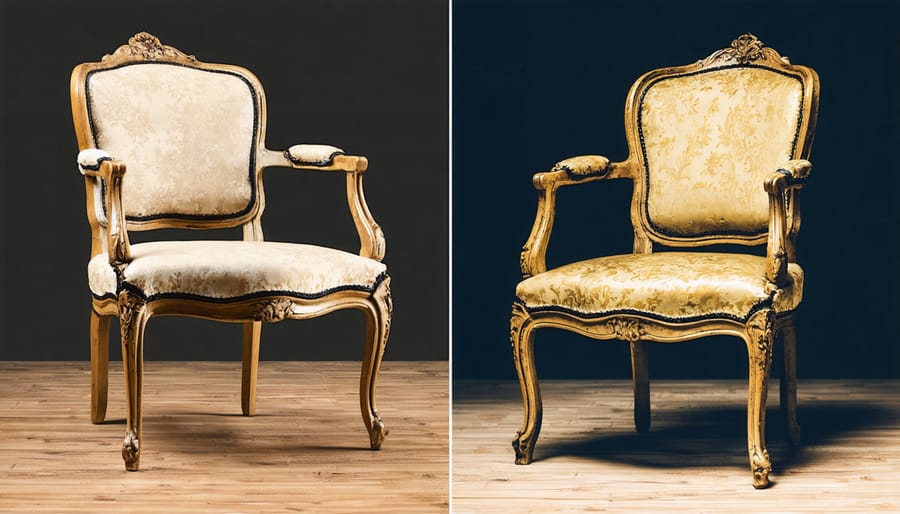
Sustainable furniture represents more than just an eco-friendly trend—it’s becoming a crucial cornerstone of responsible home design and environmental stewardship. As global resources become increasingly scarce, the choices we make about our furniture have far-reaching impacts on both our planet and future generations. From responsibly sourced materials to innovative recycling techniques, sustainable furniture practices are revolutionizing how we furnish our spaces while minimizing our environmental footprint.
Today’s conscious consumers are discovering that sustainable furniture doesn’t mean compromising on style or quality. Instead, it offers unique opportunities to create beautiful, durable living spaces while supporting environmental conservation. Whether through choosing pieces crafted from reclaimed wood, opting for furniture made with non-toxic finishes, or extending the life of existing pieces through proper maintenance, sustainable furniture practices are accessible to everyone.
This comprehensive guide explores practical approaches to incorporating sustainability into your furniture choices, from selection and maintenance to disposal and recycling. By understanding the principles of furniture sustainability, you’ll be equipped to make informed decisions that benefit both your home and the environment.

Keeping your furniture clean doesn’t have to harm the environment or your health. These proven natural cleaning solutions deliver exceptional results while maintaining your commitment to sustainability. Start with a basic all-purpose cleaner by mixing equal parts white vinegar and water, adding a few drops of lemon essential oil for a fresh scent and enhanced cleaning power.
For wooden furniture, combine 1/4 cup olive oil with 1/4 cup white vinegar to create a natural polish that both cleans and nourishes. This mixture is particularly effective when used alongside our tried-and-tested natural wood treatment secrets for optimal results.
Tackle tough stains with a paste made from baking soda and water. This gentle yet effective abrasive can remove water marks and light scratches without damaging the surface. For leather furniture, mix one part white vinegar with two parts linseed oil to create a natural conditioner that cleans while preventing cracks and drying.
To protect upholstery, combine 2 cups of warm water with 1/4 cup castile soap and 15 drops of tea tree oil. This solution naturally disinfects and deodorizes while being gentle on fabrics. Remember to always test these solutions on a small, hidden area first to ensure compatibility with your furniture’s materials.
When it comes to maintaining sustainable furniture, choosing the right eco-friendly products makes all the difference. We’ve tested numerous green cleaning solutions and identified several standout options that deliver excellent results while protecting both your furniture and the environment.
For wooden furniture, Seventh Generation’s Wood Cleaner provides exceptional results using plant-based ingredients and essential oils. It’s particularly effective on both finished and unfinished surfaces without leaving harmful residues. Another excellent choice is Method’s Wood for Good Polish, which uses natural coconut oil to restore shine while being completely biodegradable.
For upholstery, the ECOS Furniture Polish & Cleaner offers impressive stain-removing power while being completely non-toxic and hypoallergenic. We’ve found that Biokleen’s Bac-Out Stain Remover works wonders on organic stains and eliminates odors using enzyme-based technology rather than harsh chemicals.
For leather furniture, Dr. Bronner’s Pure-Castile Soap diluted with water creates an effective, gentle cleaner that won’t strip the natural oils. Alternatively, Leather Honey’s Cleaner is biodegradable and specifically formulated for all types of leather.
Remember to always test these products on a small, inconspicuous area first. These recommendations not only help preserve your furniture but also contribute to a healthier indoor environment and reduced environmental impact. By choosing these eco-friendly options, you’re investing in both your furniture’s longevity and our planet’s future.
Strategic furniture placement isn’t just about aesthetics – it’s crucial for extending the life of your pieces while maintaining their sustainability. Start by keeping furniture away from direct sunlight, which can cause fading, warping, and material degradation. Position larger pieces at least 12 inches from windows or use UV-protective window films to minimize sun damage.
Consider air flow and humidity levels when arranging furniture. Keep items away from heating vents and air conditioning units, as extreme temperature fluctuations can cause wood to expand and contract, leading to structural issues. In humid areas, maintain a distance of at least 6 inches between furniture and walls to prevent moisture buildup and potential mold growth.
For upholstered pieces, rotate cushions and swap seating positions regularly to ensure even wear. Heavy furniture should be placed on protective pads to prevent floor damage and reduce the strain on joints and legs. In high-traffic areas, create clear pathways to minimize accidental bumps and scratches.
Be mindful of room dynamics when positioning furniture. Areas near entries should feature more durable pieces that can withstand frequent use. Consider seasonal adjustments – moving sensitive items away from windows during summer months and maintaining distance from fireplaces during winter.
For wooden furniture, avoid placing pieces directly on concrete floors, as moisture can seep up through the material. Instead, use moisture barriers or elevate slightly with furniture feet. By implementing these strategic placement techniques, you’ll significantly extend the lifespan of your furniture while maintaining its quality and reducing the need for premature replacement.

Maintaining your furniture throughout the year isn’t just about preserving its beauty – it’s about implementing smart maintenance habits that protect both your investment and the environment. Each season brings unique challenges that require specific attention to ensure your furniture remains sustainable and long-lasting.
Spring calls for a thorough cleaning to address winter dust accumulation and moisture damage. Use eco-friendly cleaning solutions like diluted white vinegar for wood surfaces and natural fabric cleaners for upholstery. Check for any water damage that may have occurred during the humid winter months.
Summer maintenance focuses on protecting furniture from intense sunlight and heat. Rotate cushions regularly to prevent uneven fading, and consider using UV-protective window films. For outdoor furniture, apply natural wood sealants and cover pieces during extreme weather conditions.
Fall is the perfect time to prepare furniture for the coming winter. Tighten loose joints, condition leather with natural oils, and clean upholstery before the indoor heating season begins. Consider using humidity controls to prevent wood from drying and cracking during winter months.
Winter maintenance emphasizes moisture control and protection from heating systems. Keep furniture away from direct heat sources, use humidifiers to maintain optimal moisture levels, and regularly dust to prevent buildup that can lead to surface degradation.
Remember to document your maintenance activities and schedule regular professional assessments to catch potential issues early. This proactive approach not only extends furniture life but also reduces the need for resource-intensive replacements, supporting both sustainability goals and long-term cost savings.
Choosing repair over replacement isn’t just about saving money – it’s about making sustainable choices that benefit our environment. Several key indicators can help you determine when repair is the optimal choice. First, consider the furniture’s structural integrity; if the basic frame is solid and stable, most cosmetic or functional issues can be addressed through eco-friendly repair solutions.
Quality pieces, especially those made from solid wood or high-grade materials, are prime candidates for restoration. These items often have superior craftsmanship that’s worth preserving, and their durability makes them excellent investments in sustainable living. Antique or vintage furniture pieces particularly deserve consideration for repair, as they often feature construction methods and materials that are superior to many modern alternatives.
Consider repair when the damage is localized rather than widespread. Issues like loose joints, scratched surfaces, torn upholstery, or broken components can typically be fixed without compromising the piece’s integrity. Additionally, if the furniture holds sentimental value or matches your existing décor perfectly, restoration can preserve these important aspects while maintaining sustainability.
The environmental impact of furniture disposal is significant, so when repair costs less than 50% of replacement value and the item has years of potential use ahead, choosing restoration helps reduce landfill waste and conserves resources used in manufacturing new pieces.
When seeking eco-conscious furniture repair services, start by researching companies that explicitly state their commitment to sustainable practices. Look for repair professionals who use water-based finishes, natural oils, and low-VOC products in their restoration work. These environmentally friendly alternatives are safer for both your home and the planet.
A truly sustainable repair service should prioritize salvaging and restoring original materials whenever possible, rather than defaulting to replacements. Ask about their waste management practices – responsible providers will have systems in place for proper disposal of chemicals and recycling of materials like metal hardware and wood scraps.
Check if the repair service sources local materials when replacements are necessary. Local sourcing reduces transportation emissions and supports regional economies. Additionally, inquire about their use of reclaimed or certified sustainable wood products for repairs that require new materials.
Consider repair professionals who are certified in green practices or belong to environmental organizations. Many reputable services will showcase their eco-credentials and sustainable methodologies on their websites or marketing materials. Don’t hesitate to ask for examples of their sustainable repair work and specific details about their environmentally friendly processes.
Remember to read customer reviews focusing on the quality and longevity of repairs. A truly sustainable repair should not only be environmentally conscious but also long-lasting, preventing the need for frequent fixes or replacements.

Professional restoration represents the pinnacle of furniture sustainability, offering a comprehensive solution that goes beyond simple repairs. When you choose to restore rather than replace, you’re not just saving money – you’re making a significant environmental impact by keeping valuable pieces out of landfills and reducing the demand for new manufacturing.
Expert restoration specialists employ professional restoration techniques that can breathe new life into virtually any piece of furniture. From antique family heirlooms to modern designer pieces, skilled craftsmen can address issues like water damage, structural weakness, upholstery wear, and finish deterioration while maintaining the piece’s original character and integrity.
The benefits of professional restoration extend beyond sustainability. Restored furniture often increases in value, especially when dealing with antique or high-quality pieces. The process preserves the original materials and craftsmanship while incorporating modern durability improvements, resulting in furniture that can last for generations to come.
Consider the environmental impact: A single restored dining table can save up to 100 pounds of wood from entering landfills. Additionally, professional restoration typically uses fewer resources and produces less carbon emissions compared to manufacturing new furniture. Many restoration experts now prioritize eco-friendly finishing products and sustainable materials in their work, further reducing the environmental footprint.
The restoration process also supports local economies by maintaining traditional craftsmanship skills and creating specialized jobs in the community. These artisans combine time-honored techniques with modern sustainable practices, ensuring that each piece receives the perfect balance of historical preservation and environmental consciousness.
For commercial properties and homeowners alike, professional restoration offers a smart investment in both sustainability and style. By choosing restoration over replacement, you’re not just preserving furniture – you’re participating in one of the most effective forms of recycling available in the furniture industry.
Sustainable furniture maintenance is not just about preserving your investments – it’s about contributing to a greener future while enjoying beautiful, lasting pieces in your home or business. By implementing the practices discussed throughout this guide, you can significantly extend the life of your furniture while minimizing environmental impact.
Remember that regular cleaning with eco-friendly products, prompt attention to repairs, and proper preventive care are your best allies in sustainable furniture maintenance. These practices not only protect your furniture but also reduce the need for replacements, ultimately decreasing furniture waste in landfills.
Consider establishing a maintenance schedule for your furniture pieces, incorporating seasonal deep cleaning and regular inspections for early problem detection. When repairs are needed, choose professional restoration services that use environmentally conscious methods and materials. This approach often proves more cost-effective and environmentally responsible than replacing furniture.
By embracing sustainable furniture care, you’re not only preserving cherished pieces but also making a positive environmental impact. Whether you’re a homeowner caring for family heirlooms or a property manager maintaining commercial furniture, these sustainable practices will help ensure your furniture remains beautiful and functional for years to come while supporting our planet’s well-being.
Let’s commit to being responsible furniture owners by choosing maintenance over replacement whenever possible, and making sustainability a priority in our furniture care decisions.